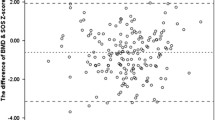Abstract
The aim of the current study was to evaluate bone status at the radius and phalanx in children and adolescents with type 1 diabetes by using quantitative ultrasound (QUS) measurements. Thirty pediatric patients, 16 male and 14 female, with type 1 diabetes of duration of 5 to 177 months and mean (± SD) age 11.3 ± 4.6 years were studied. QUS measurements were carried out using the Sunlight Omnisense 7000 S device. Speed of sound (SOS) was measured at the radius and tibia. Diabetic control was assessed by glycosylated hemoglobin (HbA1c) measurements. Male and female patients with type 1 diabetes did not have significantly different SOS or HbA1c values. SOS Z-scores at both the radius and tibia were negatively associated with duration of disease (r = −0 41 and r = −0.37 for the radius and tibia respectively, P < 0.05 for both correlations). Seven of 15 patients with duration of disease of >6 years had diminished SOS, defined as Z-score of <−1, at either the radius or tibia. SOS measurements at the radius showed moderate correlation with SOS at the tibia (r = 0.58, P < 0.00 l). There was no correlation between SOS and HbA1c. In conclusion, SOS Z-scores at both the radius and tibia show a significant negative correlation with duration of insulin-dependent diabetes in children. No relation was found between SOS and metabolic control of young diabetic patients.


Similar content being viewed by others
References
C Njeh N Shaw J Gardner-Medwin C Boivin T Southwood (2000) ArticleTitleUse of quantitative ultrasound to assess bone status in children with juvenile idiopathic arthritis. J Clin Densitom 3 251–260 Occurrence Handle10.1385/JCD:3:3:251 Occurrence Handle1:STN:280:DC%2BD3M%2FovVCmsg%3D%3D Occurrence Handle11090232
M Lequin I Sluis Particlevan der Heuvel-Eibrink den Particlevan et al. (2003) ArticleTitleA longitudinal study using tibial ultrasonometry as a bone assessment technique in children with acute lymphoblastic leukaemia. Pediatr Radiol 33 162–167 Occurrence Handle12612813
W Pluskiewicz P Adamczyk B Drozdzowska et al. (2002) ArticleTitleSkeletal status in children, adolescents and young adults with end-stage renal failure treated with hemo- or peritoneal dialysis. Osteoporos Int 13 353–357 Occurrence Handle10.1007/s001980200039
RB Mazess HS Barden ES Ohlrich (1990) ArticleTitleSkeletal and body-composition effects of anorexia-nervosa. Am J Clin Nutr 52 438–441 Occurrence Handle1:STN:280:By%2BA28rgtVY%3D Occurrence Handle2393006
J Pascual J Argente M Lopez et al. (1998) ArticleTitleBone mineral density in children and adolescents with diabetes mellitus type 1 of recent onset. Calcif Tissue Int 62 31–35
J Schepper ParticleDe J Smitz S Rosseneu P Bollen O Louis (1998) ArticleTitleLumbar spine bone mineral density in diabetic children with recent onset. Horm Res 50 193–196 Occurrence Handle10.1159/000023273 Occurrence Handle9838239
P Gunczler R Lanes V Paz-Martinez et al. (1998) ArticleTitleDecreased lumbar spine bone mass and low bone turnover in children and adolescents with insulin dependent diabetes mellitus followed longitudinally. J Pediatr Endocrinol Metab 11 413–419 Occurrence Handle1:STN:280:DC%2BD3Mvntl2kuw%3D%3D Occurrence Handle11517957
P Gunczler R Lanes M Paoli R Martinis O Villaroel et al. (2001) ArticleTitleDecreased bone mineral density and bone formation markers shortly after diagnosis of clinical type 1 diabetes mellitus. J Pediatr Endocrinol Metab 14 525–528 Occurrence Handle1:STN:280:DC%2BD3MzhslKisg%3D%3D Occurrence Handle11393573
C Njeh T Fuerst E Diessel H Genant (2001) ArticleTitleIs quantitative ultrasound dependent on bone structure? A reflection. Osteoporos Int 12 1–15 Occurrence Handle10.1007/s001980170151 Occurrence Handle1:STN:280:DC%2BD3M3ivFKhsQ%3D%3D Occurrence Handle11305077
C Langton S Palmer R Porter (1984) ArticleTitleThe measurement of broadband ultrasonic attenuation in cancellous bone. Engl J Med 13 89–91 Occurrence Handle1:STN:280:BiuB283hsFI%3D
D Hans SK Srivastav C Singal et al. (1999) ArticleTitleDoes combining the results from multiple bone sites measured by a new ultrasound device improve discrimination of hip fracture? J Bone Miner Res 14 644–651 Occurrence Handle1:STN:280:DyaK1M3ltVyntA%3D%3D Occurrence Handle10234587
C Njeh I Saeed M Grigorian et al. (2001) ArticleTitleAssessment of bone status using speed of sound at multiple anatomical sites. Ultrasound Med Biol 27 1337–1345 Occurrence Handle10.1016/S0301-5629(01)00437-9 Occurrence Handle1:STN:280:DC%2BD3MnosFKqsw%3D%3D Occurrence Handle11731047
K Knapp G Blake I Fogelman D Doyle T Spector (2002) ArticleTitleMultisite quantitative ultrasound: Colles’ fracture discrimination in postmenopausal women. Osteoporos Int 13 474–479 Occurrence Handle10.1007/s001980200057
R Barkmann E Kantorovich C Singal et al. (2000) ArticleTitleA new method for quantitative ultrasound measurements at multiple skeletal sites: first results of precision and fracture discrimination. J Clin Densitom 3 1–7 Occurrence Handle1:STN:280:DC%2BD3c3htFyksA%3D%3D Occurrence Handle10745297
A Levine L Mishna A Ballin et al. (2002) ArticleTitleUse of quantitative ultrasound to assess osteopenia in children with Crohn disease. J Pediatr Gastroenterol Nutr 35 169–172 Occurrence Handle10.1097/00005176-200208000-00012 Occurrence Handle12187292
F Falcini G Bindi M Ermini et al. (2000) ArticleTitleComparison of quantitative calcaneal ultrasound and dual energy X-ray absorptiometry in the evaluation of osteoporotic risk in children with chronic rheumatic diseases. Calcif Tissue Int 67 19–23
KM Knapp GM Blake TD Spector et al. (2001) ArticleTitleMultisite quantitative ultrasound: precision, age- and menopause-related changes, fracture discrimination, and T-score equivalence with dual-energy X-ray absorptiometry. Osteoporos Int 12 456–464 Occurrence Handle1:STN:280:DC%2BD3Mzpt1ensQ%3D%3D Occurrence Handle11446561
J Damilakis G Papadokostakis H Vrahoriti et al. (2003) ArticleTitleUltrasound velocity through the cortex of phalanges, radius, and tibia in normal and osteoporotic postmenopausal women using a new multisite quantitative ultrasound device. Invest Radiol 38 207–211 Occurrence Handle10.1097/00004424-200304000-00004 Occurrence Handle12649644
CF Njeh CW Kuo CM Langton HI Atah CM Boivin (1997) ArticleTitlePrediction of human femoral bone strength using ultrasound velocity and BMD: an in vitro study. Osteoporos Int 7 471–477 Occurrence Handle10.1007/s001980050035 Occurrence Handle1:STN:280:DyaK1c%2Fos1KnsQ%3D%3D Occurrence Handle9425506
D Hans C Wu CF Njeh et al. (1999) ArticleTitleUltrasound velocity of trabecular cubes reflects mainly bone density and elasticity. Calcif Tissue Int 64 18–23 Occurrence Handle10.1007/s002239900572 Occurrence Handle1:CAS:528:DyaK1MXktVynsA%3D%3D Occurrence Handle9868278
CC Gluer M Vahlensieck KG Faulkner K Engelke D Black et al. (1992) ArticleTitleSite-matched calcaneal measurements of broadband ultrasound attenuation and single X-ray absorptiometry: do they measure different skeletal properties? J Bone Miner Res 7 1071–1079 Occurrence Handle1414499
Author information
Authors and Affiliations
Corresponding author
Rights and permissions
About this article
Cite this article
Damilakis, J., Galanakis, E., Mamoulakis, D. et al. Quantitative Ultrasound Measurements in Children and Adolescents with: Type 1 Diabetes. Calcif Tissue Int 74, 424–428 (2004). https://doi.org/10.1007/s00223-003-0164-8
Received:
Accepted:
Published:
Issue Date:
DOI: https://doi.org/10.1007/s00223-003-0164-8




